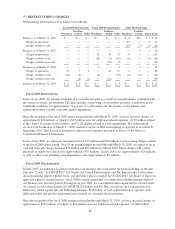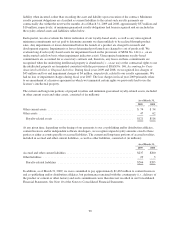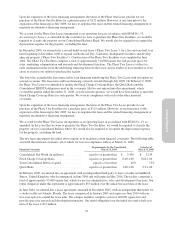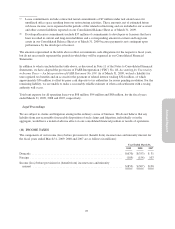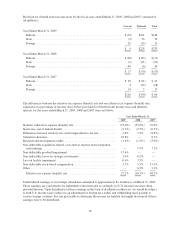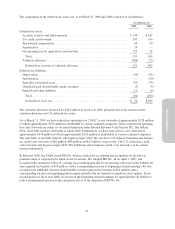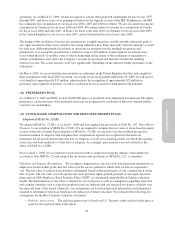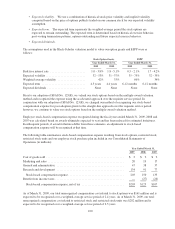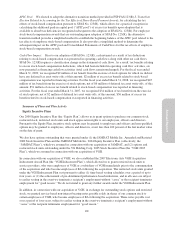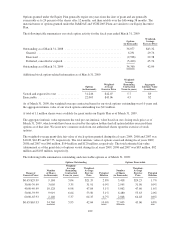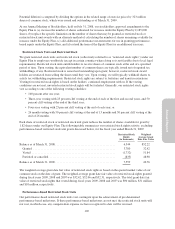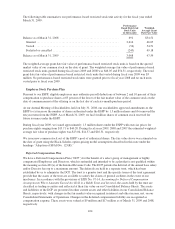Electronic Arts 2009 Annual Report Download - page 174
Download and view the complete annual report
Please find page 174 of the 2009 Electronic Arts annual report below. You can navigate through the pages in the report by either clicking on the pages listed below, or by using the keyword search tool below to find specific information within the annual report.
In July 2003, we entered into a lease agreement with an independent third party (the “Landlord”) for a studio
facility in Los Angeles, California, which commenced in October 2003 and expires in September 2013 with two
five-year options to extend the lease term. Additionally, we have options to purchase the property after five and
ten years based on the fair market value of the property at the date of sale, a right of first offer to purchase the
property upon terms offered by the Landlord, and a right to share in the profits from a sale of the property.
Existing campus facilities comprise a total of 243,000 square feet and provide space for research and
development functions. Our rental obligation under this agreement is $50 million over the initial ten-year term of
the lease. This commitment is offset by expected sublease income of $6 million for a sublease to an affiliate of
the Landlord of 18,000 square feet of the Los Angeles facility, which commenced in October 2003 and expires in
September 2013.
Development, Celebrity, League and Content Licenses: Payments and Commitments
The products we produce in our studios are designed and created by our employee designers, artists, software
programmers and by non-employee software developers (“independent artists” or “third-party developers”). We
typically advance development funds to the independent artists and third-party developers during development of
our games, usually in installment payments made upon the completion of specified development milestones.
Contractually, these payments are generally considered advances against subsequent royalties on the sales of the
products. These terms are set forth in written agreements entered into with the independent artists and third-party
developers.
In addition, we have certain celebrity, league and content license contracts that contain minimum guarantee
payments and marketing commitments that may not be dependent on any deliverables. Celebrities and
organizations with whom we have contracts include: FIFA, FIFPRO Foundation, and FAPL (Football
Association Premier League Limited) (professional soccer); NASCAR (stock car racing); National Basketball
Association (professional basketball); PGA TOUR and Tiger Woods (professional golf); National Hockey
League and NHL Players’ Association (professional hockey); Warner Bros. (Harry Potter); New Line
Productions and Saul Zaentz Company (The Lord of the Rings); Red Bear Inc. (John Madden); National Football
League Properties and PLAYERS Inc. (professional football); Collegiate Licensing Company (collegiate football
and basketball); Viacom Consumer Products (The Godfather); ESPN (content in EA SPORTS games); Twentieth
Century Fox Licensing and Merchandising (The Simpsons), Hasbro, Inc. (a wide array of Hasbro intellectual
properties), and the Estate of Robert Ludlum (Robert Ludlum novels and films). These developer and content
license commitments represent the sum of (1) the cash payments due under non-royalty-bearing licenses and
services agreements, and (2) the minimum guaranteed payments and advances against royalties due under
royalty-bearing licenses and services agreements, the majority of which are conditional upon performance by the
counterparty. These minimum guarantee payments and any related marketing commitments are included in the
table below. During the fiscal year 2009, we declined to exercise our option to invest in the Arena Football
League.
The following table summarizes our minimum contractual obligations and commercial commitments as of
March 31, 2009 (in millions):
Contractual Obligations
Commercial
Commitments
Total
Fiscal Year
Ending March 31, Leases(a)
Developer/
Licensor
Commitments(b) Marketing
Letter of Credit,
Bank and
Other Guarantees
2010 .............................. $ 50 $ 270 $ 92 $ 3 $ 415
2011 .............................. 39 263 54 — 356
2012 .............................. 29 182 42 — 253
2013 .............................. 21 152 42 — 215
2014 .............................. 27 13 24 — 64
Thereafter ......................... 20 622 131 — 773
Total .......................... $186 $1,502 $385 $ 3 $2,076
94






